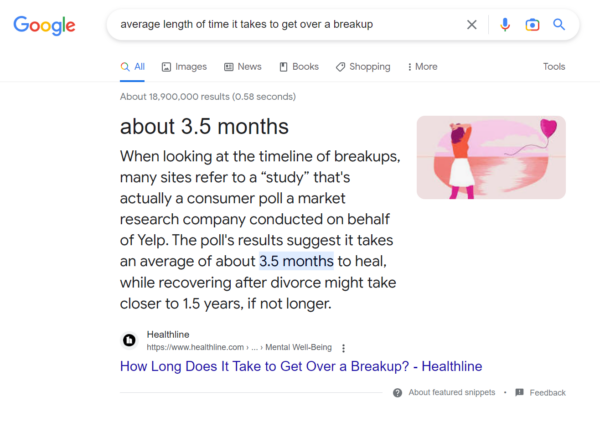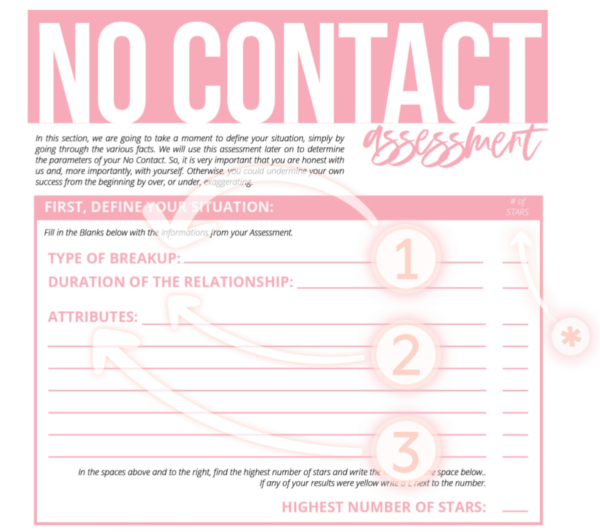Today I’m going to answer the age old question on if 4 months of no contact is too long after a breakup.
Let’s just jump right into it,
I personally believe that 4 months of no contact is too long because most exes will have begun to move on from you by that point.
So really, I guess it’s a function of figuring out what you want out of your situation.
- Do you want to get your ex back? If so, then you might want to employ a shorter no contact period.
- Do you want to get over your ex? Well then, 4 months of no contact might be right up your ally.
But let’s jump into the discussion portion of this because what I thought might end up being an incredibly boring one turned into a fascinating one when I ended up starting the research portion.

What Are Your Chances of Getting Your Ex Boyfriend Back?
Take the quizWhy 4 Months Of No Contact Is A Big No No
So, the crux of my argument is going to center around two concepts.
- The average length of time it takes to get over a breakup
- The habit rule.
So, generally there are three time frames we associate with no contact.
- The 21 Day Rule
- The 30 Day Rule
- The 45 Day Rule
These three time frames all have different “situational” implementations which I cover here.
Fun fact though, a little later in this discussion I’ve actually started toying around with the idea of shifting how you choose the ideal no contact for you.
But notice how none of the three timeframes even kiss close to the 120 days of the four month mark. This is very much by design.
The Average Length Of Time It Takes To Get Over A Breakup
It doesn’t take much to figure out how long it takes to get over a breakup. All one needs to do is simply go to Google and type the phrase in and BOOM,
Taking directly from Healthline,
When looking at the timeline of breakups, many sites refer to a “study” that’s actually a consumer poll a market research company conducted on behalf of Yelp. The poll’s results suggest it takes an average of about 3.5 months to heal, while recovering after divorce might take closer to 1.5 years, if not longer.
So, 3.5 months to heal.
Interestingly, healing from divorce takes longer, 1.5 years.
I’m assuming that this is because the length of time you are together with a person is a resulting factor for this.
- On average, couples will be together 2 years before getting engaged.
- Compared to couples who are married 8 years before divorce.
This seems to suggest that how long you were with a person dictates how long it’ll take to heal from the breakup.
Since this site focuses more on dating and relationships as opposed to marriage we can assume that the 3.5 month mark is a great benchmark to use.
This means that a four month no contact rule (120 days) will end right around the time that your ex has gotten over you which is great if you don’t want your ex back but most people coming to this website do want their exes back.
The Habit Rule
The next black mark on the four month rule revolves around my own creation, the habit rule.
It’s notoriously tricky to nail down how long it takes to break a habit.
But let’s play devils advocate here for a moment. Let’s say that we wanted to identify the most difficult ex to get back. One that would fast track getting over you.

What Are Your Chances of Getting Your Ex Boyfriend Back?
Take the quizWell, the habit rule might give us some insight to how long it would take to get over you.
According to a 2009 study,
Modelling the habit formation process in individuals allowed us to calculate the time taken for automaticity scores to plateau; operationalized here as time to reach 95% of asymptote. The average modelled time to plateau in this sample was 66 days, but the range was from 18 to 254 days.
I know that’s a lot of technical talk but the study found that it took an average of 66 days for a new habit to form (or be broken.)
But the ranges were pretty wide. For some it only took 18 days, for others 254 days.
Technically speaking if your ex wanted to really get over you it could happen in as little as 18 days but it’s far more likely to hover around that 66 day mark. Going no contact for 120 days therefore might actually help speed your ex along that process if that’s not what you want to have happen.
So, this leads us to the big question.
What is the perfect no contact time frame?
The Trick To Finding Out The Perfect Time Frame For No Contact
This is something I’ve been thinking about a lot lately.
I’ve never been particularly happy with how my program currently recommends clients to choose a no contact time frame. I basically ask them to fill out this worksheet, do this quick calculation and then based on their answers determine the no contact rule.
I call it the no contact rule assessment,
I actually don’t like it.
In fact, when applying it to real world coaching I’ve found that often it comes up with the wrong time frame. Instead, I believe I’ve found a far simpler and more effective method for assigning your no contact time frame.
It’s a simple formula that takes into account your exes attachment style.
Figure out exes attachment style + Adjust NC time frame based on that
So, your ex will have one of the four core attachment styles.
- Secure – Exhibits no major core wound.
- Anxious – Exhibits a fear of abandonment
- Avoidant – Exhibits a huge desire for independence
- Fearful – Exhibits both anxious and avoidant core wounds
If Your Ex Has A Secure Attachment
Then you are going to want to do the industry standard 30 days of no contact. Nothing really shocking here.
If Your Ex Has An Anxious Core Wound
21 days is going to be prescribed. Though I’ll go out on a limb and say that most likely your ex is not going to have an anxious core wound. In fact, your ex is most likely to have an avoidant core wound.
If Your Ex Has An Avoidant Core Wound
The vast majority of our client base has exes with avoidant core wounds,

What Are Your Chances of Getting Your Ex Boyfriend Back?
Take the quiz
For exes like this you want to do 45 days because really an avoidant isn’t going to “miss you” until they believe you are over them. A 45 day rule is actually perfect for this.
It’s enough time to where you are getting closer to that 66 day mark but not enough time to where you are passing it and out of their mind completely.
Now, where people always seem to mess up revolves around the fearful avoidant attachment style.
If Your Ex Has Fearful Avoidant Core Wounds
You actually want to do a 21 day rule.
Why?
Well, because of the pogosticking effect.
One moment an avoidant core wound will appear, the next an anxious one.
But here’s the dangerous thing about fearful avoidants. When their anxious side comes to the surface, if you don’t nurture it they can actually withdraw deeper into themselves and become even more avoidant.
Now, you usually want them to do this one time during no contact but anything greater than one tends to get a little risky.
Thus, 21 days seems to be the ideal time frame for fearful avoidant exes.
Once again, notice how none of the time frames come anywhere close to 120 days. That’s because four months of no contact is just far too long and quite frankly, unnecessary.



Maggie
March 9, 2023 at 6:00 pm
Hi 🙂
What if your ex is a fearful avoidant, but you also gnatted quite a bit? A week or so before the breakup he was full out avoidant.
Coach Shaunna Nicol
April 9, 2023 at 10:19 am
HI Maggie, you need to stick with 21 day NC for some time where you allow your ex some space. Focus on yourself, where we discuss the Holy Trinity and the Ungettable Girl/Guy showing that you are moving on from the break up